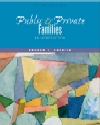EXERCISE 1
Several sites offer information and links on the topic of child abuse. The National Clearinghouse on Child Abuse and Neglect Information (www.calib.com/nccanch) provides statistics, reports, and answers to frequently asked questions. The National Committee to Prevent Child Abuse (www.childabuse.org) offers information on steps people can take to prevent child abuse. Several fact sheets are available under "publications"; select and read one or two of them. EXERCISE 2 The Family Violence Prevention Fund (www.fvpf.org) maintains a web site with stories of victims of domestic violence and people who have made a difference in reducing domestic violence. In addition, the Yahoo web site maintains a page with comprehensive links to numerous organizations and articles on domestic violence (www.yahoo.com/society_and_culture/crime/types_of_crime/domestic_violence). Explore a few of these to get a sense of the different points of view among the organizations listed. EXERCISE 3 - How Much Child Abuse? Visit the site of the National Clearinghouse on Child Abuse and Neglect Information (http://www.calib.com/nccanch/). Click on Statistics, and then scroll down to National Incidence Study of Child Abuse and Neglect and click on NIS-3 Executive Summary. Read the report and see if you can determine some facts about the extent of child abuse. Which kids are most likely to be abused by sex, age, and race? What types of abuse are most prominent and increasing the fastest? In what types of family settings was abuse more likely to occur? How were these cases of abuse being detected? EXERCISE 4 - Is Spanking Child Abuse? Were you spanked as a child? Will you spank your children? There is a heated
debate on this issue. Some (including the American Academy of Pediatrics) believe
that children should never be spanked, while others assert that it is the duty
of parents to discipline-including physically. Check out the websites for these
two points of view. For a site positioned against spanking, see http://www.neverhitachild.org/nosindex.html.
How do they frame their argument? Then visit a site which advocates spanking,
for example, http://nospank.org/n-f19.htm.
Now look at an article which attempts to give an unbiased view: http://www.usnews.com/usnews/issue/980413/13span.htm.
Here is a legal perspective on the issue: http://www.pacificjustice.org/articles_2.html.
Where does it place spanking in the public/private family distinction? Read these and see for yourself. | 


 2002 McGraw-Hill Higher Education
2002 McGraw-Hill Higher Education